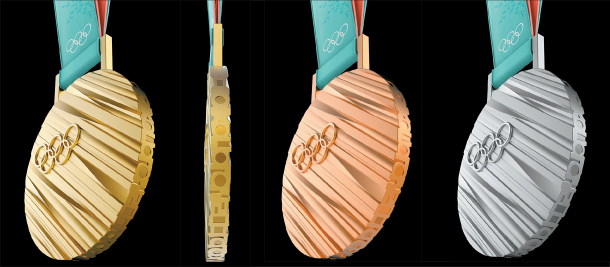Medals engraved with tradition

Close-ups, from left, of the gold medal at the PyeongChang Winter Olympics; the side of the medal, which features hangul, the Korean alphabet; the bronze medal; and the silver medal. [PYEONGCHANG ORGANIZING COMMITTEE]
The PyeongChang Winter Olympic medal design was inspired by three aspects of traditional Korean culture: hangul (the script), hanbok (clothing) and hanok (architecture).
The front of the medal consists of uneven protrusions in the shape of Korean consonants that spell out “PyeongChang Winter Olympics.” The letters are also engraved on the side.
The strap’s material is a light and translucent fabric called gapsa that is used to make traditional Korean clothing. For the strap, two colors were used — light pink and aqua blue — which complement each other nicely.
Upon closer examination, the strap is embroidered with snowflake patterns formed from Korean letters. The PyeongChang 2018 wordmark runs along the strap.
The medal’s case was inspired by the elegant and simple curves of the roofs in traditional Korean homes.
The gold medals weigh 586 grams (1.29 pounds), silver 580 grams and bronze 493 grams. In total, 777 medals have been made for the Games.
The gold and silver medals are 99.9 percent silver, and the gold medals each contain 6 grams of gold. The bronze medal is made of red brass.
Each medal is 92.5 millimeters (3.64 inches) wide, 109 millimeters long and between 4.4 millimeters and 9.42 millimeters thick.
The medal designer, Lee Suk-woo, is an industrial artist with experience working for companies like Samsung Electronics, Motorola, Teague and Fuseproject.










with the Korea JoongAng Daily
To write comments, please log in to one of the accounts.
Standards Board Policy (0/250자)